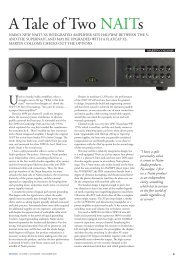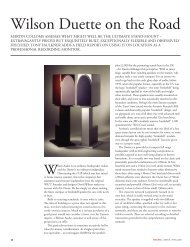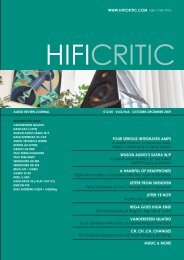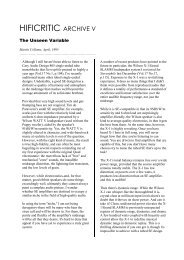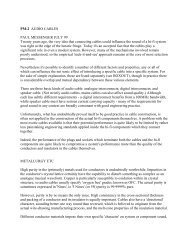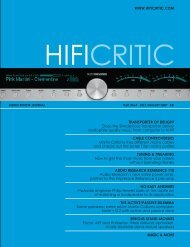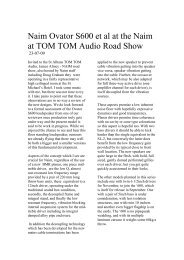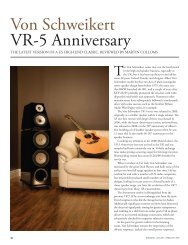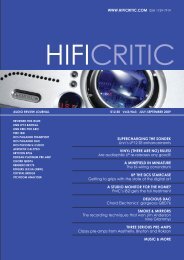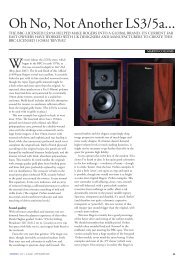You also want an ePaper? Increase the reach of your titles
YUMPU automatically turns print PDFs into web optimized ePapers that Google loves.
should not be taken too literally in terms of <strong>the</strong> analysis of sound quality; if<br />
audiophiles were fully briefed on <strong>the</strong> limitations of most designs, many would refuse<br />
to buy a speaker at all. What does matter is <strong>the</strong> subjective judgment of <strong>the</strong> final<br />
result, governed by price and expectation. As <strong>the</strong> report developed, <strong>the</strong> Duettas and<br />
<strong>the</strong> Logans begin to position <strong>the</strong>mselves at extremes of technology and specific<br />
performance, while <strong>the</strong> Magneplanar emerged as <strong>the</strong> classic, balanced, middle-of-<strong>the</strong>road<br />
contender.<br />
Design Compromises<br />
Although radically different in appearance, <strong>the</strong> Duetta and <strong>the</strong> CLS are both mediumsized,<br />
floor-standing, open-panel speakers. The Duetta is a two-way system, with a<br />
moderately sized, broad-band ribbon tweeter working through <strong>the</strong> upper mid and<br />
treble ranges. It is related to <strong>the</strong> three-way Scintilla, which uses 2 <strong>com</strong>posite<br />
multiple-ribbon systems for <strong>the</strong> mid and treble ranges.<br />
The number of “ways” is crucial to a design, since no single transducer can properly<br />
en<strong>com</strong>pass <strong>the</strong> breadth of <strong>the</strong> audible frequency range. From <strong>the</strong> design viewpoint,<br />
<strong>the</strong> more ways - i.e., <strong>the</strong> greater <strong>the</strong> number of divisions of <strong>the</strong> frequency range <strong>the</strong><br />
more freedom <strong>the</strong>re is for <strong>the</strong> engineer to trim and balance <strong>the</strong> frequency <strong>response</strong> to<br />
provide a natural sound. Conversely, with a low number of “ways” <strong>the</strong> designer has<br />
to fight for continuity and an even power over <strong>the</strong> range, not always with <strong>com</strong>plete<br />
success. Increasing <strong>the</strong> “ways” however, makes it more difficult to design a wellintegrated<br />
full-range system this difficulty greater than <strong>the</strong> increase in <strong>com</strong>plexity.<br />
Apogee Duetta Details<br />
Apogee has pioneered <strong>the</strong> use of modern “ribbon” technology, and in <strong>the</strong> case of <strong>the</strong><br />
Duetta, this description is certainly true for <strong>the</strong> HF unit. Here, a tall, pleated<br />
aluminium foil/Kapton ribbon with three series connected conducting paths is<br />
suspended between <strong>the</strong> poles of a powerful, linear, open magnet. The radiation is bidirectional<br />
and dipolar, <strong>the</strong> energy behind being out of phase by 180 degrees with that<br />
for <strong>the</strong> front. Unless placed very close to a back wall, this will not result in specific<br />
cancellation save at 90 degrees to <strong>the</strong> speaker, since by <strong>the</strong> time wall reflected rear<br />
waves have <strong>com</strong>bined with <strong>the</strong> direct radiation; <strong>the</strong>ir phase is randomly<br />
indeterminate. Suppose <strong>the</strong> panel is typically placed at five feet from <strong>the</strong> back wall,<br />
and <strong>the</strong> listener is 15 feet from <strong>the</strong> speaker. At <strong>the</strong> low frequency end of <strong>the</strong> range<br />
handled by <strong>the</strong> tweeter ribbon, say 1kHz, <strong>the</strong> listener is 15 wavelengths away from <strong>the</strong><br />
front-panel sound, and 25 wavelengths from <strong>the</strong> reflected sound to <strong>the</strong> rear. Given<br />
normal room reflections, specific cancellations will be diffused and of small<br />
significance; with reducing frequency, however, this factor will assume increasing<br />
importance.<br />
The lower frequency range of <strong>the</strong> Duetta is handled by a stretched film diaphragm,<br />
tensioned and supported over its whole boundary perimeter, also a dipole, and<br />
quaintly referred to by Apogee as a “ribbon”. Its motion is akin to a drum skin, as is<br />
that of <strong>the</strong> Magneplanars and <strong>the</strong> vast majority of electrostatics. This is quite distinct<br />
from <strong>the</strong> piston-like, push-pull, action of a freely suspended ribbon whose<br />
fundamental to-and-fro resonance may be so low as to occur below <strong>the</strong> audible range.<br />
At present, it is inconceivable that a loudspeaker could be made to operate full range



